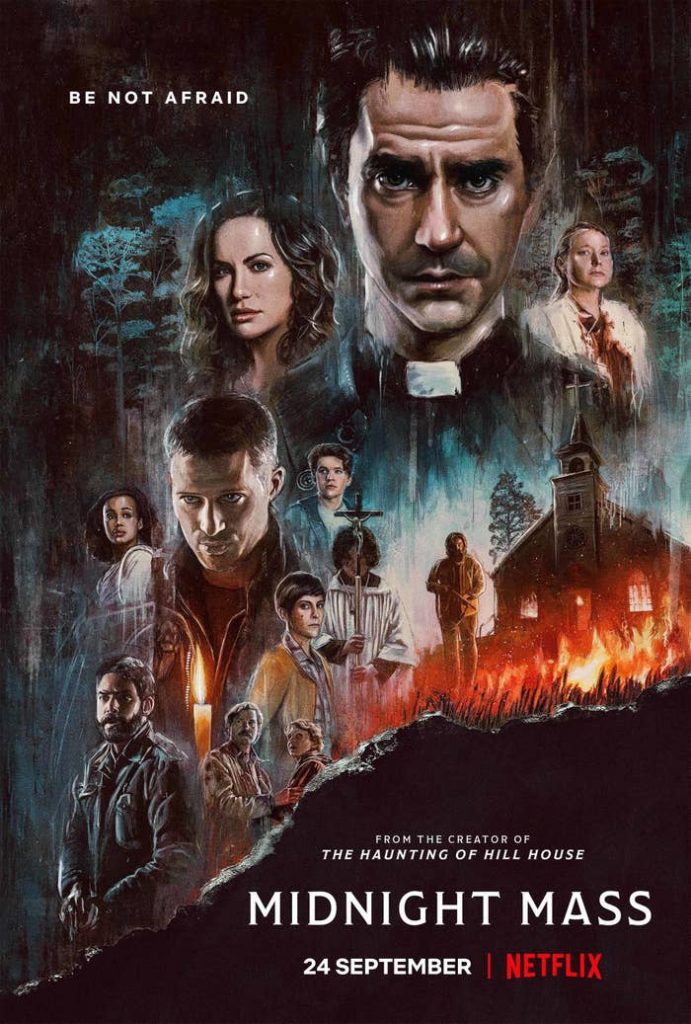Midnight Mass
Introduction
“While you’re at it, ask Him why He always takes the kids, while the drunk f***s walk away with scratches..”
As alcoholic Riley Flynn sits – muttering the Lord’s Prayer under his breath – across the road from the wreckage of his car and the young woman he has just killed with it, the paramedic’s retort hits a bit too close to home. With inequity plaguing human society since the dawn of history, this is a question which will forever set non-believers apart from those of faith. Guilt and spiritual disillusionment reducing him to a husk of his former self, the same question dismantles years of Catholic upbringing for Riley, as he serves out his four-year sentence and returns to the place he begrudgingly calls home. Unbeknownst to him though, much has changed there since he left – and even more is about to change in the wake of his homecoming.
After being kept on hold as a potential project for nearly a decade, Midnight Mass is finally here – and let’s just say it’s possibly Flanagan’s boldest work till date. For starters, it’s miles away from the classic haunted house trope, which has been a staple of the horror maestro ever since Oculus (2013). Instead, this Netflix miniseries has an overtly religious theme, spinning interwoven tales of fall from grace and redemption, while masterfully reinventing core Catholic tenets and customs in a way that many would find sacrilegious. It is profoundly weird and weirdly profound, and while it isn’t openly scary, it will get under your skin with its slow burn. It also has one of the most heartbreaking endings I have watched on screen in a long, long time.
Story & Screenplay
Hello and welcome to Crockett Island, or as the dwindling population of this tiny fishing town likes to call it, the Crock Pot! With the mainland being 30 miles away and the only means of contact with it the twice-daily ferry, this isolated community is “so sleepy it could be dead”. Recent environmental disasters have resulted in particularly tough times for the townsfolk, most of whom are Catholic and regulars at the local St. Patrick’s Church – with the exception of the newly appointed Muslim sheriff and his son. As Riley sets foot in his hometown after years and unexpectedly meets his old flame Erin Greene (who has also made a prodigal comeback), the charismatic Father Paul Hill arrives in town, hauling a mysterious trunk and claiming to be a temporary replacement for the aged pastor Monsignor John Pruitt – who has reportedly fallen sick during his pilgrimage and is recovering in a hospital on the mainland. With miraculous healings soon taking place all over Crockett Island, the flock of believers at St. Patrick’s grows steadily, as Father Hill and his zealot associate Beverly Keane enjoy more and more influence over the population.
And that’s about as far it goes without major spoilers!
Flanagan’s Catholic background has enabled him to hide tons and tons of Biblical symbols in plain sight, which play pivotal roles in the tale. With the story taking place right before Easter which celebrates the resurrection of Jesus, these symbols range from the different colors of robes (chasuble) worn by Father Hill to the very names of the seven episodes, beginning with “Book I: Genesis” and concluding with “Book VII: Revelation”. The twisted parallels between Father Hill and Paul the Apostle, his sermons to the community of fishermen, the recurring theme of literal and metaphorical rebirth – are all hardcore Christian references. Things reach a fever pitch with the terrifying interpretation of Mass and Communion – the central motif of the story – revealing how often good can masquerade as evil and evil as good, and how difficult it is to navigate around them with a broken moral compass.
Unlike the director’s familiar style, the narrative we come across here is mostly linear, with the symbolism going hand in hand with the clear subtexts of personal trauma, guilt, indoctrination, and interfaith conflict. The copious amounts of violence and blood in the later episodes is a significant shift from Flanagan’s usual psychological horror montage. Close to the climax though, the last remaining great motif breaks through for the very first time: the stark difference between organized religion and transcendental spirituality. The final 10 minutes of “Book VII: Revelations” will shatter your heart into pieces and give you chills unlike anything else from its genre, and if you are anything like me, will surely make you return for a hypnotic rewatch!
Performance & Direction
The cast contains many familiar faces from Flanagan’s earlier productions. With Zach Gilford playing Riley Flynn and Kate Siegel as Erin Greene, it goes without saying that the two leads are in more than capable hands. Hamish Linklater does a phenomenal job of portraying Father Hill in all his charisma and conflicts – and as for the fanatic Beverly Keane, well, nothing but absolute respect for Samantha Sloyan! It’s not easy to make viewers really hate a character as much as she would get you to hate hers, all the while maintaining a magnetic screen presence right up to the very end. The supporting cast – which includes Rahul Kohli as Sheriff Hassan and Henry Thomas as Mr. Ed Flynn – stars a host of skilled artists who bring prominent side characters like Mildred Gunning (Alex Essoe), her daughter Dr. Sarah Gunning (Annabeth Gish), or the alcoholic recluse Joe Collie (Robert Longstreet) to life.
Shot across picturesque locations at Garry Point Park in British Columbia, the series, according to Flanagan, has been his personal dream project for years – one that he would sometimes refer to as “the best project I’ll never make”. For an original which has been so long in the making, it’s no wonder that the story is replete with elements from his own past – having been founded upon his own experiences as an altar boy in his youth, and partly inspired by his personal struggles with alcoholism. The road to atonement and absolution that leads many of his stories to the climax seems all too real from this angle, and Midnight Mass, being his original creation, is no exception. Die-hard fans might also discover a few amazing Easter eggs, linking the series with some of his most well-known works from the past!
While some viewers have reportedly been bored by the long monologues making their appearance throughout the story, not a single one of those is out of place or unnecessary. Speaking for myself, they form the philosophical backbone of the tale and dramatically flesh out some of the characters – and we all know how often it’s utterly impossible to capture in lens what can only be conveyed through words and words alone. In fact, my only quibble has to do with the total runtime of Midnight Mass, which I feel could have done better as a ten-episode series like The Haunting of Hill House. As the story picks up pace in E03 (“Book III: Proverbs”), events from the later episodes sometimes appear a little rushed, as it feels like certain side characters could do with a bit more attention and/or screen time. Then again, with “7” being such an important number in the gospel, the total number of “books” seems to have been set in stone. Maybe slightly longer episodes then!
Music
“That’s what it means to have faith. That in the darkness, in the worst of it, in the absence of light and hope, we sing.”
This quote seems to have struck a literal chord with the music department, whose awesome job deserves a separate round of applause. Starting off with “And The Grass Won’t Pay No Mind” by Neil Diamond behind the mind-numbing opening scene, what strikes most about the mainstream songs used in this series is just how deliberately they often mock the scenes unfolding on screen while sardonically foreshadowing the events to come. The list includes Ed and Annie Flynn dancing to “Holly Holy”, and Leonard Cohen’s “Democracy” being sung on the stage during the feast of Crock Pot Luck. It is only with the gift of hindsight and a rewatch that the true relevance of these songs becomes clear.
That being said, the true homage to the show’s religious theme is the multitude of Catholic hymns used especially in the later episodes. From the deeply penitent vibes of “Abide With Me” to “Holy Holy Holy” in the background of the ominous nightly vigil scene, you’ll often find them building up from a barely audible hum to an angelic choir at some really unholy moments, serving as powerful portents of the all-too-possible corruption of orthodox religion and the emergence of mass fanaticism. But not all of them are bound to the same grim motif. The hauntingly beautiful choral song used in the climactic moments – “Nearer, My God, To Thee” – will give you goosebumps all over, as Crockett Island finally makes peace with the redemption that has been a long time coming.
Conclusion
Midnight Mass is all about reading between the lines, and you’ll have to keep your eyes peeled throughout in order to appreciate all the subtle flavors this masterpiece has to offer. While a little knowledge of the Bible definitely helps you get into the heart of things and connect with the various allusions, the show is equally gripping and terrifying for viewers with no such background, as its messages transcend the limits of any particular religion. It is a modern-day parable in every sense of the word, and ranks up there with the very best from its genre. If you’re a fan of horror, stream it immediately. If you aren’t one, stream it all the same. You won’t be disappointed!




